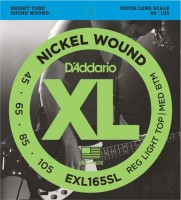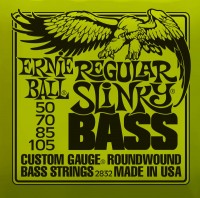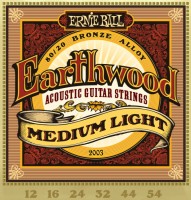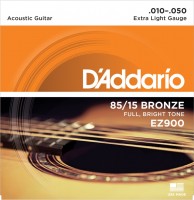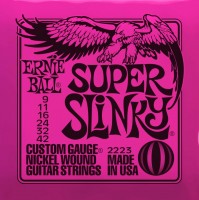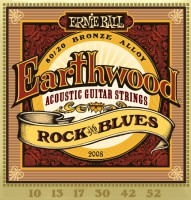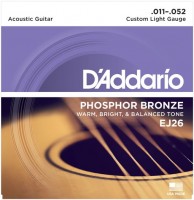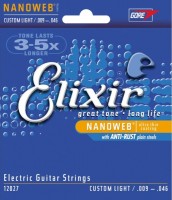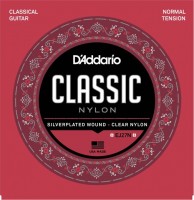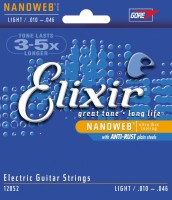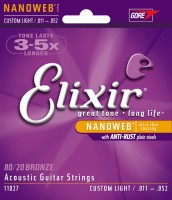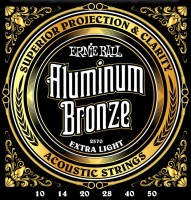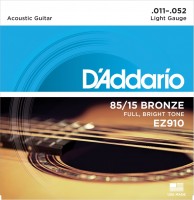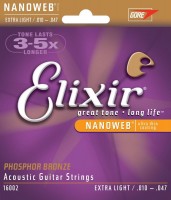Strings DAddario
All Strings Advanced filters → |
You might be interested in
Strings: specifications, types
Features
The instrument for which the string or set of strings is intended.
Each instrument has its own stringing requirements, and even similar varieties can have very different stringing requirements. For this reason, it is highly recommended not to put "non-native" strings on the instrument, even if it seems technically possible. For example, you can’t put metal strings from an acoustic guitar on a classical guitar : the “classic” is designed for nylon, and the metal tension force can deform or even break the instrument. In turn, nylon strings on an acoustic guitar will sound too quiet and soft. There are also strings for electric and acoustic bass guitars, for different types of bowed ones, etc.
Each instrument has its own stringing requirements, and even similar varieties can have very different stringing requirements. For this reason, it is highly recommended not to put "non-native" strings on the instrument, even if it seems technically possible. For example, you can’t put metal strings from an acoustic guitar on a classical guitar : the “classic” is designed for nylon, and the metal tension force can deform or even break the instrument. In turn, nylon strings on an acoustic guitar will sound too quiet and soft. There are also strings for electric and acoustic bass guitars, for different types of bowed ones, etc.
Scale
The scale is the distance from the nut to the nut of the instrument, in fact, the working length of the string in the open position (when it is not clamped with a finger). If a string is used with a scale that is too long, there is a chance that it will simply not be long enough, and if the scale is too short, most of the string will have to be cut. In addition, with a "non-native" scale, there is a chance that the string will not build on the frets.
The scale division depends on the type of instrument (see "Intended use"). Here are the most common options and important nuances:
— Classical and acoustic guitars can have a reduced body; a full-size tool is designated as 4/4, a smaller one is indicated by a smaller fraction, such as 3/4 or 1/2. Smaller guitars also require special strings designed for the appropriate scale length; they are marked according to the size of the case for which they are intended.
— In strings for full-size guitars (including electric ones), the scale is usually not indicated. Such instruments may vary in actual scale length, but this is taken into account in the design, and normal action can be achieved by selecting the appropriate tension.
— In bass guitars, there are 4 standard scale options: short (up to 32"), medium (32 – 34"), long (34 – 36") and extra long (36 – 38").
— Among the ukulele there are also 4 varieties. In order of increasing size and decreasing tun...ing: soprano, concerto, tenor and baritone. Each has its own scale length, which is taken into account in specialized strings.
The scale division depends on the type of instrument (see "Intended use"). Here are the most common options and important nuances:
— Classical and acoustic guitars can have a reduced body; a full-size tool is designated as 4/4, a smaller one is indicated by a smaller fraction, such as 3/4 or 1/2. Smaller guitars also require special strings designed for the appropriate scale length; they are marked according to the size of the case for which they are intended.
— In strings for full-size guitars (including electric ones), the scale is usually not indicated. Such instruments may vary in actual scale length, but this is taken into account in the design, and normal action can be achieved by selecting the appropriate tension.
— In bass guitars, there are 4 standard scale options: short (up to 32"), medium (32 – 34"), long (34 – 36") and extra long (36 – 38").
— Among the ukulele there are also 4 varieties. In order of increasing size and decreasing tun...ing: soprano, concerto, tenor and baritone. Each has its own scale length, which is taken into account in specialized strings.
In set
The total number of strings included in the package.
Strings can be sold individually or in sets designed for one or another instrument. The number of strings in such a set is determined primarily by the type of instrument (see "Purpose"). So, ukuleles and many types of bowed instruments have 4 strings, bass guitars — from 4 to 6, classical guitars — strictly 6 strings, acoustic — 6 or 12; electric guitars are usually six-string, but there are models for 7 and even 8 strings; and for a harp, this number can reach several tens.
Usually, sets are made complete, that is, they are intended to replace all the strings at once; incomplete sets are almost never found on the market. So if the strings are not completely replaced, the musician, usually, has to buy them separately.
Strings can be sold individually or in sets designed for one or another instrument. The number of strings in such a set is determined primarily by the type of instrument (see "Purpose"). So, ukuleles and many types of bowed instruments have 4 strings, bass guitars — from 4 to 6, classical guitars — strictly 6 strings, acoustic — 6 or 12; electric guitars are usually six-string, but there are models for 7 and even 8 strings; and for a harp, this number can reach several tens.
Usually, sets are made complete, that is, they are intended to replace all the strings at once; incomplete sets are almost never found on the market. So if the strings are not completely replaced, the musician, usually, has to buy them separately.
String
The serial number of the string.
This parameter is given if the strings are sold individually. The number can be indicated for different instruments, here are the most popular options:
— For traditional six-string guitar strings (classical, acoustic or electric), the number can be from 1 (thinnest) to 6 (thickest) string.
— Among electric guitars there are models that have 7 and even 8 strings (the so-called baritone guitars)..
— On traditional four-string bass guitars, the strings are numbered similarly to conventional guitars — in ascending order of thickness, from first to fourth. However, on the market you can find the "fifth" and "sixth" bass strings — these are options for five- and six-string instruments, thinner strings than in a standard 4-string set.
Sequence number information is indispensable for finding a single string; in fact, without knowing the number, it will be simply impossible to find the right string. And the need for such a purchase may arise both because of a broken or worn string, or because of a factory defect (for example, poor-quality winding that quickly lost its integrity). The first strings are especially popular among novice musicians — they are the most often torn.
This parameter is given if the strings are sold individually. The number can be indicated for different instruments, here are the most popular options:
— For traditional six-string guitar strings (classical, acoustic or electric), the number can be from 1 (thinnest) to 6 (thickest) string.
— Among electric guitars there are models that have 7 and even 8 strings (the so-called baritone guitars)..
— On traditional four-string bass guitars, the strings are numbered similarly to conventional guitars — in ascending order of thickness, from first to fourth. However, on the market you can find the "fifth" and "sixth" bass strings — these are options for five- and six-string instruments, thinner strings than in a standard 4-string set.
Sequence number information is indispensable for finding a single string; in fact, without knowing the number, it will be simply impossible to find the right string. And the need for such a purchase may arise both because of a broken or worn string, or because of a factory defect (for example, poor-quality winding that quickly lost its integrity). The first strings are especially popular among novice musicians — they are the most often torn.
String material
— Steel. Relatively inexpensive and at the same time functional material that provides a bright, resonant sound. Bronze (regular or phosphorus) is most often used in the winding of steel strings for acoustic guitars, copper and nickel are also found in electric guitars and basses. A separate category is represented by steel strings with nylon winding, for more details on them, see "Braid material".
— Nylon. A soft synthetic material primarily used in classical guitar strings. Such tools do not handle well the tension required for metal; Nylon strings don't stretch as much. For the same reason, this option is considered optimal for beginner guitarists: the synthetic string does not cut into fingers so much and is more comfortable for musicians who have not had time to develop “guitar calluses”. At the same time, we note that nylon bass strings usually still have a metal winding. But the sound of the "synthetics" is quite soft, close to the classical sound of the Spanish guitar. Also note that this material stretches quite a lot, which is why the system of new strings periodically “floats away” at first, and the guitar pegs have to be twisted, restoring the tension.
— Nickel-plated steel. Nickel-plated steel strings are popular in "power tools" like electric guitars and basses. The winding is usually made from the same material as the core. This option combi...nes the good magnetic properties of steel and the corrosion resistance of nickel; the strings are softer than steel strings, so the nut does not wear out as quickly. The sound of nickel-plated steel is somewhat quieter and softer than that of ordinary steel, but brighter and louder than that of pure nickel.
— Nickel. Another variant popular in electric guitars and basses. Nickel has a very soft, "warm" and rich sound and is considered perfect for jazz, classic rock and other similar styles. Also, nickel itself is somewhat softer than steel, which makes it easier to clamp the strings and reduce wear on the nut. Braiding in nickel strings can be made from the same material or nickel-plated steel for a more resonant, bright sound.
— Titan. Quite strong and durable, but expensive material. Unlike steel, titanium is able to sound normal at a fairly low tension. As a result, such strings are found even in classical guitar sets; usually the first three (thinnest) strings are made of titanium, the rest are standard synthetics or metal-wrapped composite. Titanium strings are brighter and more resonant than traditional nylon, plus they last longer and have little to no drag.
— Tin. A variant found primarily among banjo strings. The name "tin" is not too accurate, because. usually in this case it is not pure tin that is meant, but classical bronze — an alloy of copper and tin. According to its properties, this composition is considered almost perfect for metal banjo strings, but it is practically never found in guitar strings.
— Nylon. A soft synthetic material primarily used in classical guitar strings. Such tools do not handle well the tension required for metal; Nylon strings don't stretch as much. For the same reason, this option is considered optimal for beginner guitarists: the synthetic string does not cut into fingers so much and is more comfortable for musicians who have not had time to develop “guitar calluses”. At the same time, we note that nylon bass strings usually still have a metal winding. But the sound of the "synthetics" is quite soft, close to the classical sound of the Spanish guitar. Also note that this material stretches quite a lot, which is why the system of new strings periodically “floats away” at first, and the guitar pegs have to be twisted, restoring the tension.
— Nickel-plated steel. Nickel-plated steel strings are popular in "power tools" like electric guitars and basses. The winding is usually made from the same material as the core. This option combi...nes the good magnetic properties of steel and the corrosion resistance of nickel; the strings are softer than steel strings, so the nut does not wear out as quickly. The sound of nickel-plated steel is somewhat quieter and softer than that of ordinary steel, but brighter and louder than that of pure nickel.
— Nickel. Another variant popular in electric guitars and basses. Nickel has a very soft, "warm" and rich sound and is considered perfect for jazz, classic rock and other similar styles. Also, nickel itself is somewhat softer than steel, which makes it easier to clamp the strings and reduce wear on the nut. Braiding in nickel strings can be made from the same material or nickel-plated steel for a more resonant, bright sound.
— Titan. Quite strong and durable, but expensive material. Unlike steel, titanium is able to sound normal at a fairly low tension. As a result, such strings are found even in classical guitar sets; usually the first three (thinnest) strings are made of titanium, the rest are standard synthetics or metal-wrapped composite. Titanium strings are brighter and more resonant than traditional nylon, plus they last longer and have little to no drag.
— Tin. A variant found primarily among banjo strings. The name "tin" is not too accurate, because. usually in this case it is not pure tin that is meant, but classical bronze — an alloy of copper and tin. According to its properties, this composition is considered almost perfect for metal banjo strings, but it is practically never found in guitar strings.
Braid
The presence of an additional braid on a string or strings from a set — at least some (for example, in kits for six-string guitars, only 3 – 4 of the thickest strings usually have a braid).
The purpose of the braid may be different. Most often, it is used to give the string the necessary thickness and at the same time maintain a softness sufficient for normal use. In addition, the winding can correct the physical or acoustic properties of the base material of the string, giving it the necessary performance characteristics (sound colour, tightness to the nut, etc.). See below for details on the different braid materials. If there is a winding, but its material is not specified separately, this most often means that the manufacturer for some reason did not indicate this data. One reason for this step could be that the braid material matches the warp material (see "String Material").
The purpose of the braid may be different. Most often, it is used to give the string the necessary thickness and at the same time maintain a softness sufficient for normal use. In addition, the winding can correct the physical or acoustic properties of the base material of the string, giving it the necessary performance characteristics (sound colour, tightness to the nut, etc.). See below for details on the different braid materials. If there is a winding, but its material is not specified separately, this most often means that the manufacturer for some reason did not indicate this data. One reason for this step could be that the braid material matches the warp material (see "String Material").
Braid material
Many types of materials are described above in the "String Material" section, most of what is written there is also relevant for braids — especially when the string is wrapped with the same material from which it is made. Here we will only touch on some of the nuances associated with individual materials.
— Copper. It is used in different types of strings — nylon for classical guitar, bronze for "acoustics", etc. as an inexpensive alternative to bronze. The copper braid gives a quite clean and balanced sound, but it sounds more muffled than "silver" (see below), and does not have the features characteristic of ordinary or phosphor bronze.
— Silver. Most often, in this case, it means copper coated with a thin layer of silver. This braid is a classic option for "bass" nylon strings used in classical guitars. The silver coating gives the copper braid the necessary sonority, while the price of such a combination is quite affordable. On the other hand, silver wears off rather quickly. But combining a "silver" braid with a steel base does not make sense, and although such strings are found on the market, they do not have any special advantages over pure steel or bronze.
— Nickel. Nickel braid is popular primarily in electric guitar strings. In this case, the core of the string can be made both from the same material and from steel; the first option giv...es a denser and smoother sound, the second one is brighter and more sonorous (although not as sonorous as pure steel). And the unequivocal advantages of nickel windings are softness (due to which the wear of the nut is reduced) and “slipperiness” (fingers slide well along the strings, which makes it easier to perform some playing techniques).
— Cobalt. Another braid material used in electric guitar strings. Cobalt has a high magnetic permeability, which allows the strings to interact more effectively with the pickups, increases the output level and (according to the manufacturer) improves the frequency response. In addition, this material is resistant to wear, has good durability, and fingers glide well over it. The disadvantage of cobalt is a rather high cost (both due to the price of the material itself, and because of the “premium” positioning of strings with cobalt braid).
— Nylon. This material is used for winding metal, usually steel strings, including in bass guitars. Nylon braid can have a different design, sometimes quite unusual. So, in some strings, only a “case” is made of nylon — a protective coating, inside of which there is a string with a sheath (also metal). In other models, a nylon coating is applied to the metal wire, and after that the string is wrapped with it. In both cases, synthetics prevent string contamination from sweat and dirt from fingers, and also improves fit to the nut and prevents flattening of the winding from constant pressing. As a result, the string retains its original sound (roughly speaking, "plays like new") longer than when uncoated. On the other hand, this material noticeably muffles the strings and does not allow to achieve a bright, “iridescent” sound.
— Nickel-plated chrome. A variant found in double bass strings. Chromium provides the tape with hardness and durability, reducing wear on contact with the fingerboard and with the bow. Nickel somewhat muffles the sonorous timbre of chrome, giving the instrument the necessary softness of sound. However, for a number of reasons, this option has not received much distribution.
— Nickel-plated bronze. Bronze braid complemented by nickel plating. Found in acoustic guitar strings. The coating provides corrosion resistance to the strings, extending their life and making them easier to store. As for acoustics, nickel somewhat softens and “warms” the sound of yellow bronze.
— Bronze. In this case, the so-called yellow bronze (actually brass). It is mainly used in strings for acoustic guitars. Yellow bronze is characterized by a fairly bright and sonorous sound, often with a characteristic clanging (which many musicians consider a virtue). However, this material is sensitive to corrosion and requires special attention during storage — otherwise the bronze braid will begin to oxidize, which will negatively affect both appearance and sound.
— Phosphor bronze. A darker variety of bronze, with a reddish tinge. Also used primarily in acoustic guitars. The sound of such strings, in comparison with yellow bronze, turns out to be softer and smoother, without ringing and clanging, but with more pronounced depth and clear bass.
— Aluminium bronze. A type of bronze in which the main component, in addition to copper, is aluminium. Both in terms of coloration of the sound, and outwardly similar to yellow bronze, while it can be brighter and more brilliant. However, the main advantage of this material over yellow bronze is its high resistance to corrosion — such a braid normally tolerates even a long stay in conditions of high humidity. On the other hand, such strings cost accordingly.
— Aluminium. Aluminium winding is found in strings for bowed instruments of the "higher" range (in particular, violins and violas), both steel and nylon. This material is quite versatile, it is suitable for providing a sonorous, bright sound, and for softer, warmer tones; It can be said that the sound of aluminium braided strings depends more on the material of the string itself. With all this, aluminium is durable and resists bow friction well.
— Titan. Another material used in strings for bowed instruments. In fact, it is a “premium version” of the aluminium described above: titanium is stronger and more durable, in addition, it practically does not stretch, but it also costs more.
— Copper. It is used in different types of strings — nylon for classical guitar, bronze for "acoustics", etc. as an inexpensive alternative to bronze. The copper braid gives a quite clean and balanced sound, but it sounds more muffled than "silver" (see below), and does not have the features characteristic of ordinary or phosphor bronze.
— Silver. Most often, in this case, it means copper coated with a thin layer of silver. This braid is a classic option for "bass" nylon strings used in classical guitars. The silver coating gives the copper braid the necessary sonority, while the price of such a combination is quite affordable. On the other hand, silver wears off rather quickly. But combining a "silver" braid with a steel base does not make sense, and although such strings are found on the market, they do not have any special advantages over pure steel or bronze.
— Nickel. Nickel braid is popular primarily in electric guitar strings. In this case, the core of the string can be made both from the same material and from steel; the first option giv...es a denser and smoother sound, the second one is brighter and more sonorous (although not as sonorous as pure steel). And the unequivocal advantages of nickel windings are softness (due to which the wear of the nut is reduced) and “slipperiness” (fingers slide well along the strings, which makes it easier to perform some playing techniques).
— Cobalt. Another braid material used in electric guitar strings. Cobalt has a high magnetic permeability, which allows the strings to interact more effectively with the pickups, increases the output level and (according to the manufacturer) improves the frequency response. In addition, this material is resistant to wear, has good durability, and fingers glide well over it. The disadvantage of cobalt is a rather high cost (both due to the price of the material itself, and because of the “premium” positioning of strings with cobalt braid).
— Nylon. This material is used for winding metal, usually steel strings, including in bass guitars. Nylon braid can have a different design, sometimes quite unusual. So, in some strings, only a “case” is made of nylon — a protective coating, inside of which there is a string with a sheath (also metal). In other models, a nylon coating is applied to the metal wire, and after that the string is wrapped with it. In both cases, synthetics prevent string contamination from sweat and dirt from fingers, and also improves fit to the nut and prevents flattening of the winding from constant pressing. As a result, the string retains its original sound (roughly speaking, "plays like new") longer than when uncoated. On the other hand, this material noticeably muffles the strings and does not allow to achieve a bright, “iridescent” sound.
— Nickel-plated chrome. A variant found in double bass strings. Chromium provides the tape with hardness and durability, reducing wear on contact with the fingerboard and with the bow. Nickel somewhat muffles the sonorous timbre of chrome, giving the instrument the necessary softness of sound. However, for a number of reasons, this option has not received much distribution.
— Nickel-plated bronze. Bronze braid complemented by nickel plating. Found in acoustic guitar strings. The coating provides corrosion resistance to the strings, extending their life and making them easier to store. As for acoustics, nickel somewhat softens and “warms” the sound of yellow bronze.
— Bronze. In this case, the so-called yellow bronze (actually brass). It is mainly used in strings for acoustic guitars. Yellow bronze is characterized by a fairly bright and sonorous sound, often with a characteristic clanging (which many musicians consider a virtue). However, this material is sensitive to corrosion and requires special attention during storage — otherwise the bronze braid will begin to oxidize, which will negatively affect both appearance and sound.
— Phosphor bronze. A darker variety of bronze, with a reddish tinge. Also used primarily in acoustic guitars. The sound of such strings, in comparison with yellow bronze, turns out to be softer and smoother, without ringing and clanging, but with more pronounced depth and clear bass.
— Aluminium bronze. A type of bronze in which the main component, in addition to copper, is aluminium. Both in terms of coloration of the sound, and outwardly similar to yellow bronze, while it can be brighter and more brilliant. However, the main advantage of this material over yellow bronze is its high resistance to corrosion — such a braid normally tolerates even a long stay in conditions of high humidity. On the other hand, such strings cost accordingly.
— Aluminium. Aluminium winding is found in strings for bowed instruments of the "higher" range (in particular, violins and violas), both steel and nylon. This material is quite versatile, it is suitable for providing a sonorous, bright sound, and for softer, warmer tones; It can be said that the sound of aluminium braided strings depends more on the material of the string itself. With all this, aluminium is durable and resists bow friction well.
— Titan. Another material used in strings for bowed instruments. In fact, it is a “premium version” of the aluminium described above: titanium is stronger and more durable, in addition, it practically does not stretch, but it also costs more.
Braid shape
— Round. The classic version, which appeared first and still does not lose popularity due to its simplicity, low cost and functionality. From an acoustic point of view, the round braid contributes to the sonority of the sound. When sliding your fingers along such a string, a characteristic “buzz” occurs, but for many guitarists this is not a disadvantage, and some even use this sound as an additional playing technique.
— Flat. Flatwound strings have an almost flat surface with only the characteristic spiral pattern between the turns. Other things being equal, flat winding, compared to round winding, gives a softer, warmer, perhaps even slightly muffled tone of sound. Also, such strings allow you to perform more "clean" slides, without a buzzing sound when you move your finger along the string, and wear out the frets less.
— Semi-flat. To obtain such a winding, a round wire is used, which, during processing, is smoothed from the outside. Thus, a semi-flat winding is a kind of middle option between flat and round: flat on the outside, round on the inside. Thanks to this, it combines many advantages of a flat braid (“careful attitude” to the frets, no noise when sliding a finger) with a rather sonorous sound.
— Elliptical. The winding of this type in the section has a slightly flattened shape, however, unlike the se...mi-flat, its surface is closer to the usual round winding, and the turns are quite pronounced. In fact, the "ellipse" is a modification of the round winding, designed to reduce fret wear and at the same time preserve the sonorous and clear sound as much as possible.
— Flat. Flatwound strings have an almost flat surface with only the characteristic spiral pattern between the turns. Other things being equal, flat winding, compared to round winding, gives a softer, warmer, perhaps even slightly muffled tone of sound. Also, such strings allow you to perform more "clean" slides, without a buzzing sound when you move your finger along the string, and wear out the frets less.
— Semi-flat. To obtain such a winding, a round wire is used, which, during processing, is smoothed from the outside. Thus, a semi-flat winding is a kind of middle option between flat and round: flat on the outside, round on the inside. Thanks to this, it combines many advantages of a flat braid (“careful attitude” to the frets, no noise when sliding a finger) with a rather sonorous sound.
— Elliptical. The winding of this type in the section has a slightly flattened shape, however, unlike the se...mi-flat, its surface is closer to the usual round winding, and the turns are quite pronounced. In fact, the "ellipse" is a modification of the round winding, designed to reduce fret wear and at the same time preserve the sonorous and clear sound as much as possible.
Ball
The number of balls provided in the design of the string(s).
A small metal ball (or similar device) is attached to the end of the string and is used to secure it to the tailpiece. In nylon strings for classical guitars, such devices are not used at all — the strings are tied with a special knot around the holes in the bridge. In other cases, most often a ball is enough at one end of the string — with this side the string is fixed in the hole of the tailpiece, and the other end is passed into the hole of the peg and wrapped around it. However, there are strings with two balls at both ends; such models are usually designed for "headless" guitars and basses, in which there is no headstock and the upper ends of the strings are attached to a special clamp. However, there are few such instruments, which is why the "two-headed" strings are not widely used.
A small metal ball (or similar device) is attached to the end of the string and is used to secure it to the tailpiece. In nylon strings for classical guitars, such devices are not used at all — the strings are tied with a special knot around the holes in the bridge. In other cases, most often a ball is enough at one end of the string — with this side the string is fixed in the hole of the tailpiece, and the other end is passed into the hole of the peg and wrapped around it. However, there are strings with two balls at both ends; such models are usually designed for "headless" guitars and basses, in which there is no headstock and the upper ends of the strings are attached to a special clamp. However, there are few such instruments, which is why the "two-headed" strings are not widely used.
String diameter
The diameter of the strings in the set, from thinnest to thickest.
Thicker strings, all other things being equal, provide more volume and richness to the sound, have more overtones, and generally sound richer and warmer (high frequencies are less pronounced in the sound). However, these strings require more tension, which can make them uncomfortable for beginners and inexperienced players who are unaccustomed to high force; and the duration of the sound is relatively low. Conversely, thinner strings are softer to the touch, require less effort, give better sustain, but are thinner and more prone to rattle. Detailed recommendations on the optimal string thickness for different cases can be found in special sources (including documentation for the instrument itself and reference materials from string manufacturers).
Note that the diameter of the strings is directly related to the tension (see below), so one of these parameters is often indicated in the characteristics.
Thicker strings, all other things being equal, provide more volume and richness to the sound, have more overtones, and generally sound richer and warmer (high frequencies are less pronounced in the sound). However, these strings require more tension, which can make them uncomfortable for beginners and inexperienced players who are unaccustomed to high force; and the duration of the sound is relatively low. Conversely, thinner strings are softer to the touch, require less effort, give better sustain, but are thinner and more prone to rattle. Detailed recommendations on the optimal string thickness for different cases can be found in special sources (including documentation for the instrument itself and reference materials from string manufacturers).
Note that the diameter of the strings is directly related to the tension (see below), so one of these parameters is often indicated in the characteristics.
Tension
The tension is directly related to the diameter of the strings (see above) — thicker strings have to be stretched more. Thus, the characteristics often indicate only one of these parameters (either thickness or tension). And the list of tension options, from weakest to strongest, looks like this:
— Extra super light;
— Extra light ;
— Super light ;
— Easy ;
— Average ;
— Heavy ;
— Extra heavy.
In bowed instruments, the set of options is noticeably more modest, it includes soft (extra super light), medium and hard (heavy) tension.
In general, the "lighter" the strings are, the softer they are to the touch, and the easier they are to play. In addition, a relatively low tension gives good sustain (duration) and melodiousness of the sound. At the same time, loosely stretched strings have a thin and relatively quiet sound, and they are more likely to rattle. And vice versa, as the tension increases (and thickness increases), the sound becomes more powerful, rich, “warm”, high frequencies stand out less in it; however, the force required to compress the strings also increases accordingly.
In light of all this, for beginners, mastering the guitar, the most "light" sets are recommended — they will not cut their fingers much and make it easier to ge...t used to. But beginner violinists should choose medium-tension sets — it is best to work out the basic playing techniques on them, and only after that, if you want, you can pay attention to hard or soft strings.
Note that there are "combined" sets of strings on the market, marked with different tensions — for example, " super light / light ", " light / heavy ", etc. In such sets, thin strings have a lighter tension than thick ones: for example, 1-2-3 strings are "light", 4-5-6 are "medium". This allows you to achieve a combination of ringing high frequencies with tight and rich bass; although the specific coloration of the sound will, of course, depend on the combination of tensions.
— Extra super light;
— Extra light ;
— Super light ;
— Easy ;
— Average ;
— Heavy ;
— Extra heavy.
In bowed instruments, the set of options is noticeably more modest, it includes soft (extra super light), medium and hard (heavy) tension.
In general, the "lighter" the strings are, the softer they are to the touch, and the easier they are to play. In addition, a relatively low tension gives good sustain (duration) and melodiousness of the sound. At the same time, loosely stretched strings have a thin and relatively quiet sound, and they are more likely to rattle. And vice versa, as the tension increases (and thickness increases), the sound becomes more powerful, rich, “warm”, high frequencies stand out less in it; however, the force required to compress the strings also increases accordingly.
In light of all this, for beginners, mastering the guitar, the most "light" sets are recommended — they will not cut their fingers much and make it easier to ge...t used to. But beginner violinists should choose medium-tension sets — it is best to work out the basic playing techniques on them, and only after that, if you want, you can pay attention to hard or soft strings.
Note that there are "combined" sets of strings on the market, marked with different tensions — for example, " super light / light ", " light / heavy ", etc. In such sets, thin strings have a lighter tension than thick ones: for example, 1-2-3 strings are "light", 4-5-6 are "medium". This allows you to achieve a combination of ringing high frequencies with tight and rich bass; although the specific coloration of the sound will, of course, depend on the combination of tensions.

